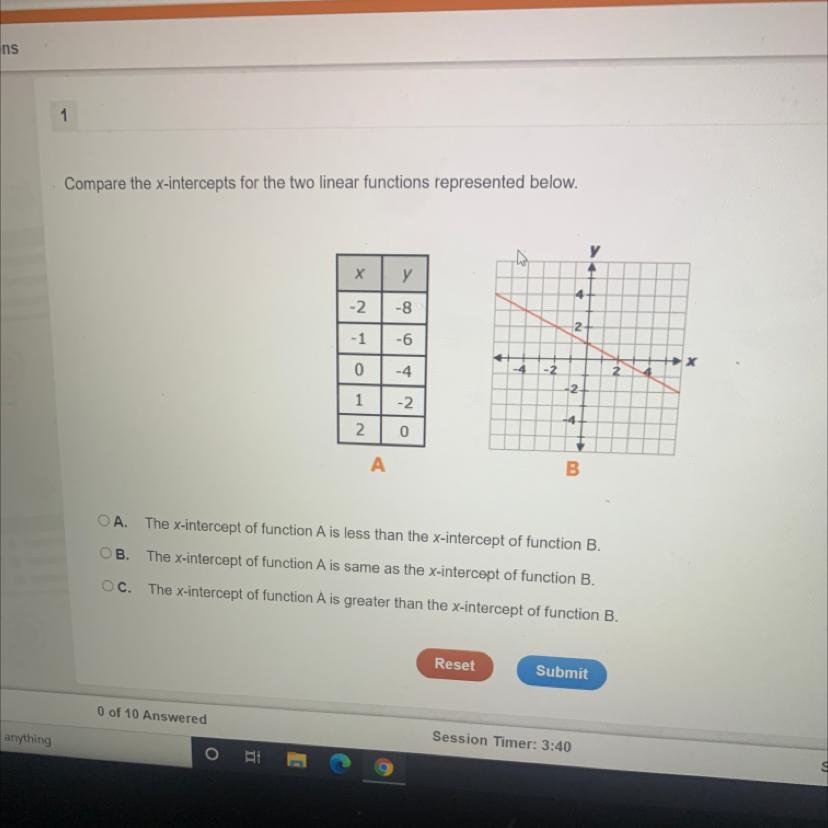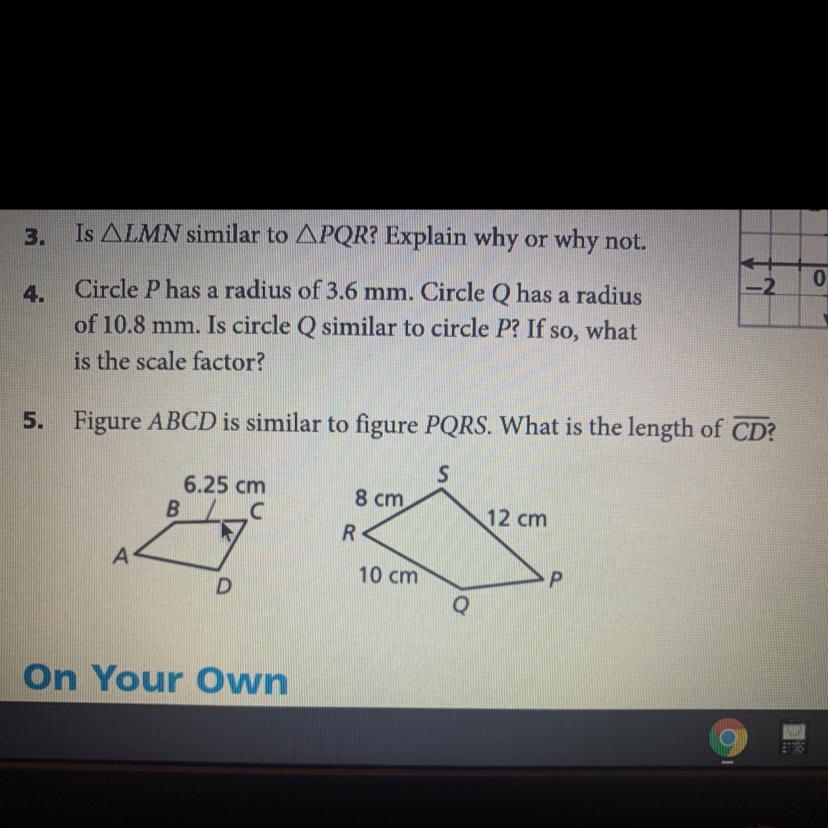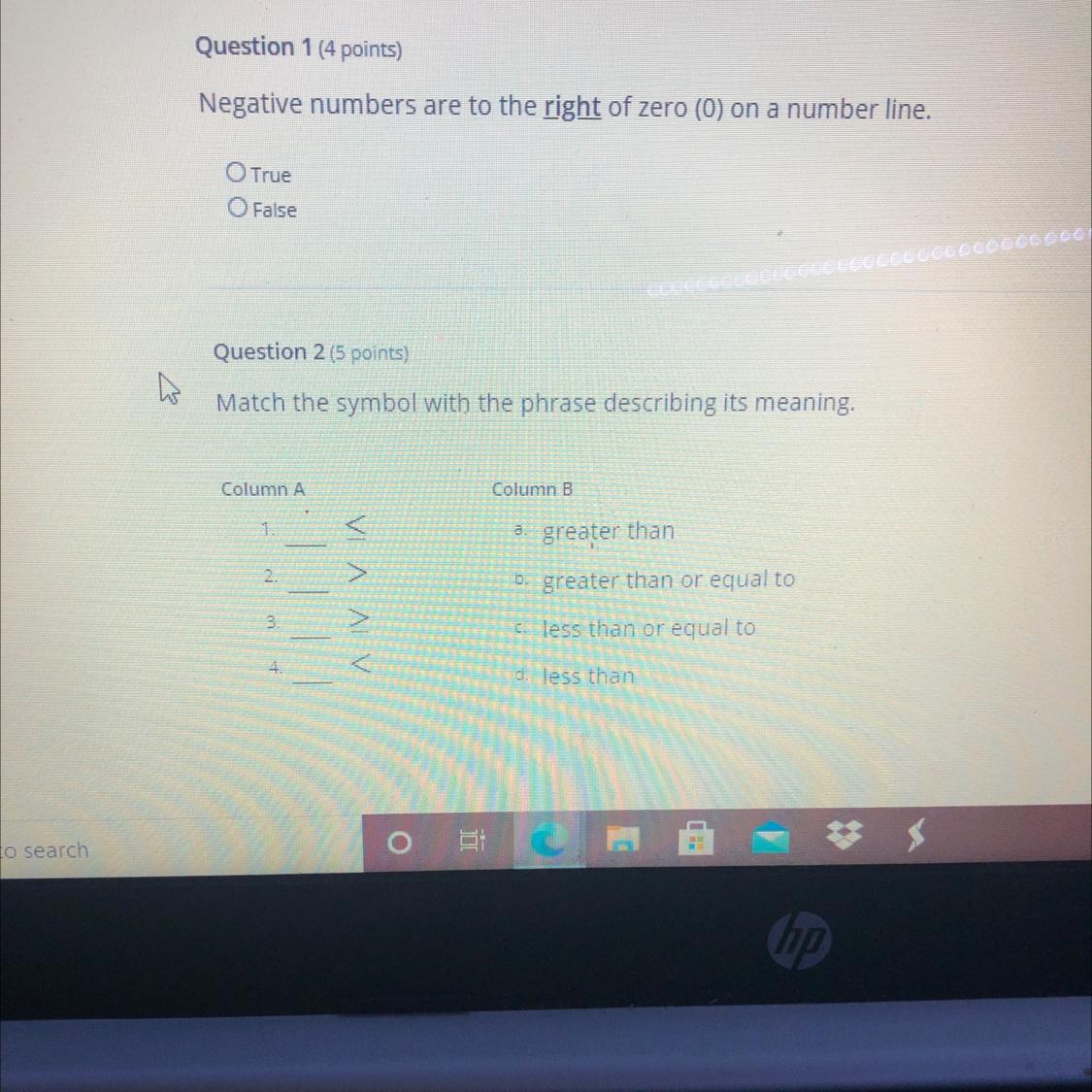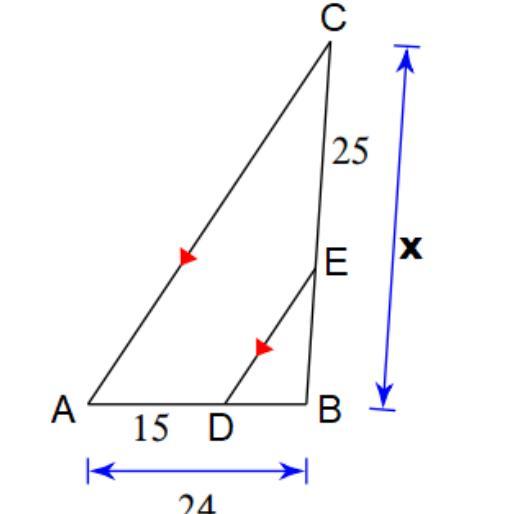2. What are all the possible rational roots of the polynomial P(x) = 5* + 2003 + 2x2 +4?
0, +1, +2, +4
+1, +2, +4, +8
+1, +2, +4
+1, +2
Answers
Step-by-step explanation:
Since all coefficients are integers, we can apply the rational zeros theorem.
The trailing coefficient (the coefficient of the constant term) is 7" role="presentation" style="margin: 0px; padding: 0px; box-sizing: border-box; font-style: normal; font-variant: inherit; font-weight: normal; font-stretch: inherit; font-size: 16px; line-height: normal; font-family: inherit; display: inline; text-indent: 0px; text-align: left; text-transform: none; letter-spacing: normal; word-spacing: normal; overflow-wrap: normal; white-space: nowrap; float: none; direction: ltr; max-width: none; max-height: none; min-width: 0px; min-height: 0px; border: 0px; position: relative;">77.
Find its factors (with the plus sign and the minus sign): ±1" role="presentation" style="margin: 0px; padding: 0px; box-sizing: border-box; font-style: normal; font-variant: inherit; font-weight: normal; font-stretch: inherit; font-size: 16px; line-height: normal; font-family: inherit; display: inline; text-indent: 0px; text-align: left; text-transform: none; letter-spacing: normal; word-spacing: normal; overflow-wrap: normal; white-space: nowrap; float: none; direction: ltr; max-width: none; max-height: none; min-width: 0px; min-height: 0px; border: 0px; position: relative;">±1±1, ±7" role="presentation" style="margin: 0px; padding: 0px; box-sizing: border-box; font-style: normal; font-variant: inherit; font-weight: normal; font-stretch: inherit; font-size: 16px; line-height: normal; font-family: inherit; display: inline; text-indent: 0px; text-align: left; text-transform: none; letter-spacing: normal; word-spacing: normal; overflow-wrap: normal; white-space: nowrap; float: none; direction: ltr; max-width: none; max-height: none; min-width: 0px; min-height: 0px; border: 0px; position: relative;">±7±7.
These are the possible values for p" role="presentation" style="margin: 0px; padding: 0px; box-sizing: border-box; font-style: normal; font-variant: inherit; font-weight: normal; font-stretch: inherit; font-size: 16px; line-height: normal; font-family: inherit; display: inline; text-indent: 0px; text-align: left; text-transform: none; letter-spacing: normal; word-spacing: normal; overflow-wrap: normal; white-space: nowrap; float: none; direction: ltr; max-width: none; max-height: none; min-width: 0px; min-height: 0px; border: 0px; position: relative;">pp.
The leading coefficient (the coefficient of the term with the highest degree) is 2" role="presentation" style="margin: 0px; padding: 0px; box-sizing: border-box; font-style: normal; font-variant: inherit; font-weight: normal; font-stretch: inherit; font-size: 16px; line-height: normal; font-family: inherit; display: inline; text-indent: 0px; text-align: left; text-transform: none; letter-spacing: normal;
Related Questions
Given the figure, find the values of x and z.

Answers
\(\\ \sf\longmapsto 8x-38=90\)
\(\\ \sf\longmapsto 8x=90+38\)
\(\\ \sf\longmapsto 8x=128\)
\(\\ \sf\longmapsto x=16\)
Now
\(\\ \sf\longmapsto z+90=180\)
\(\\ \sf\longmapsto z=90\)
Select all statements that are true. 0.55 < 6/9 5.15 = 5 2/6 0.70 < 3 4/5 2.5 < 2 3/4
Answers
Answer:
A: 0.55 < \(\frac{6}{9}\)
C: 0.70 < \(3\frac{4}{5}\)
D: 5 < \(2\frac{3}{4}\)
Step-by-step explanation:
Turn all the fractions into decimals.
A: 0.55 < 0.67 (Correct)
B: 5.15 = 5.33 (Incorrect)
C: 0.70 < 3.8 (Correct)
D: 2.5 < 2.75 (Correct)
Given cos theta = √3/3 and sin theta < 0. What is the value of sin theta?
Answers
The value of the sin theta will be equal to \(Sin\theta =\sqrt{\dfrac{2}{3}}\)
What is trigonometry?The branch of mathematics sets up a relationship between the sides and the angles of the right-angle triangle termed trigonometry.
Given that:-
Cos\(\theta\) = √3/3 Sin\(\theta\) <0The value of Sin will be calculated as:-
\(Sin^2\theta +Cos^2\theta = 1\\\\Sin^2\theta + \dfrac{\sqrt{3}}{2}=1\\\\Sin^2\theta = 1 -\dfrac{1}{3}\\\\Sin\theta = \sqrt{\dfrac{2}{3}}\)
We can see that the value of sin is less than zero therefore
To know more about Trigonometry follow
https://brainly.com/question/24349828
#SPJ1
Set, in a triangle ABC, points B 'and C such that B' divides side CA in the ratio 4: 4 from C, and C divides side AB in the ratio 3: 5 from A. Denote the point of intersection between BB 'and CC with T. The vectors AB and AC in the triangle are non-parallel and therefore form a base in the plane. Determine the coordinates of the vector AT in this base.
Answers
To determine the coordinates of vector AT in this base, we first need to find the coordinates of points B' and C.
Let's start by finding the coordinates of B'. Since B' divides side CA in the ratio 4:4 from C, we can use the following formula to find its coordinates:
B' = (4C + 4A)/8
Simplifying this expression, we get:
B' = (C + A)/2
Similarly, we can find the coordinates of C using the fact that it divides AB in the ratio 3:5 from A:
C = (3A + 5B)/8
Now, we can use these coordinates to find the equation of lines BB' and CC.
The equation of line BB' can be found using the point-slope form:
BB': y - yB = (yB' - yB)/(xB' - xB) * (x - xB)
Substituting the coordinates of B and B', we get:
BB': y - 0 = (yB'/2)/(xB'/2) * (x - 1)
Simplifying this expression, we get:
BB': y = (yB'/xB') * x - yB'/2
Similarly, we can find the equation of line CC:
CC: y = (yC'/xC') * x - yC'/2
Now, we can find the coordinates of point T by solving the system of equations formed by the equations of lines BB' and CC:
(yB'/xB') * x - yB'/2 = (yC'/xC') * x - yC'/2
Simplifying this expression, we get:
x = (yC' - yB') / ((yC'/xC') - (yB'/xB'))
Substituting this value of x into the equation of line BB', we get:
y = (yB'/xB') * ((yC' - yB') / ((yC'/xC') - (yB'/xB'))) - yB'/2
Simplifying this expression, we get:
y = ((yB' * xC') - (yC' * xB')) / (2 * (xC' - xB'))
Now, we can find the coordinates of point T:
T = (x, y)
Substituting the coordinates of B', C, and T into the expression for vector AT, we get:
AT = T - A
Simplifying this expression, we get:
AT = ((x - xA), (y - yA))
In triangle ABC, let B' and C' be points on sides CA and AB, respectively. B' divides CA in a 4:4 ratio from C, meaning CB':B'A = 4:4, and C' divides AB in a 3:5 ratio from A, meaning AC':C'B = 3:5.
Let A be the origin, and let AB = a and AC = b be the vectors forming a base in the plane. Since B' divides CA in half, the position vector of B' is the midpoint of CA, so B' = (1/2)b. Similarly, C' divides AB in a 3:5 ratio, so C' = (5/8)a.
Now, let's consider triangle B'C'T. Since T is the intersection of BB' and CC', we can write the vectors BT and CT in terms of B'T and C'T, respectively:
BT = B'T + TB
CT = C'T + TC
Since B'T and C'T are parallel to b and a, respectively, we can write:
BT = k1 * b
CT = k2 * a
Here, k1 and k2 are constants. Now, using the ratios CB':B'A and AC':C'B, we can write:
k1 * b = 4 * (TB - (1/2)b)
k2 * a = 5 * (TC - (5/8)a)
Finally, we want to find the vector AT. Since AT = TB + TC, we can substitute the expressions for TB and TC from the above equations and solve for AT:
AT = (k1 * b + (1/2)b) + (k2 * a + (5/8)a)
The coordinates of the vector AT are given in terms of the base vectors a and b, with the constants k1 and k2 accounting for the position of the point T in the triangle.
Visit here to learn more about coordinates brainly.com/question/16634867
#SPJ11
t is known that a batch of toys produced at a certain factory in a day has a defect rate of 1%. suppose the quality inspectors randomly inspect 500 toys from the batch and calculate the proportion of defective toys, what will the the sampling distribution look like? the sampling distribution would be centered around , with a standard deviation of .
Answers
Therefore, the sampling distribution will be centered around 0.01, with a standard deviation of 0.0098.
What will the the sampling distribution look like?In a random sample of 500 toys from the manufacturer batch, the fraction of defective toys will have a sampling distribution that is roughly normal.
The population proportion of defective toys will be used as the sampling distribution's mean, which is 1% or 0.01. This is thus because a proportion of the sample is a fair estimate of a proportion of the population.
The following formula can be used to determine the standard error, also known as the standard deviation, of the sample distribution:
SE is equal to sqrt[(p*(1-p))/n]
where n is the sample size, 500, and p is the population proportion of faulty toys, which is 0.01.
These values are substituted into the formula to produce:
SE is equal to sqrt[(0.01*(1-0.01))/500] = 0.0098
Learn more about standard deviation here:
brainly.com/question/23907081
#SPJ1
Distance 10
(miles)
Which unit rate represents the faster car?
Time
(minutes)
Answers
Mile/minute unit rate is represents the faster car.
Miles definedA common unit of measurement is the mile (mi). It is typically used it to represent the distance among cities, the length of rivers, and the distance between roadways. The letter "mi" stands for the unit mile in writing. Therefore, a marathon race would be roughly 26.3 mile or 26.3 mi in length.
How are miles measured?
Any point on the map that's not a location's name or emblem should be touched and held.
Count the distance between two points.
The total mileage in mile and km is shown at the bottom (km).
You can add several points, as a tip.
Tap Undo to take away the most recent addition you made. Tap More in the top right corner to erase every point. Clear.
To know more about mile visit:
brainly.com/question/23245414
#SPJ1
Distance 10(miles) Which unit rate represents the faster car? Time(minutes)
A square has a perimeter of 36 cm. What is the length of each side?
Answers
Answer:
a square has all its sides equal so you divide by 4
to get 9cm
hope it helps!Answer:
4cm
Step-by-step explanation:
4tmes side gives as perimeter
4side =36
x=4
A King in ancient times agreed to reward the inventor of chess with one grain of wheat on the first of the 64 squares of a chess board. On the second square the King would place two grains of wheat, on the third square, four grains of wheat, and on the fourth square eight grains of wheat. If the amount of wheat is doubled in this way on each of the remaining squares, what is the total weight in tons of all the wheat that will be placed on the first 59 squares? (Assume that each grain of wheat weighs 1/7000 pound. Remember that 1 ton2000 lbs.)
Answers
The number of grains on square 59 will be 5.7646075230342 x 10^17grains.
How to calculate the number of grain?No. of grains on the first square = 1 = 2^0
No. of grains on the second square = 2 = 1*2 = 2¹
No. of grains on the third square = 4 = 2*2 = 2²
No. of grains on the fourth square = 8 = 2*4 = 2³
From the pattern it could be seen that amount of wheat is doubled for every next square
So, the number of grains in the nth square = 2^n-1
Therefore, No. of grains on 59th square
= 2^59 -1 =
= 5.7646075230342 x 10^17
Learn more about sequence on:
https://brainly.com/question/6561461
#SPJ1
Amira is solving the equation x2 - 6x - 1. Which value must be added to both sides of the equation to make the left side a perfect-square trinomial?
Answers
Question 1 Let the random variable Z follow a standard normal distribution. Find the following probabilities. a) (5 points) P(Z31.72). b) (5 points) P(Z>1.1). c) (5 points) P(1.1 1070) b) (15 points) P(990 < 5 1150) Question 4 (25 points) Determine the probability that in a sample of 100 the sample proportion is less than 0.77 if p=0.8.
Answers
By answering the presented question, we may conclude that P(990< X <1150) = normal distribution P[(990-1000)/100 < Z < (1150-1000)/100] = P(-1.0 < Z < 1.5) = 0.7745
what is normal distribution?The normal distribution is an example of a continuous probability distribution, in which the majority of data points cluster at the middle of the range and the remaining ones drop symmetrically towards one of the extremes. The mean of the distribution is another term for the range's centre. According to the normal distribution, also known as the Gaussian distribution, which is symmetrical around the mean, data that are close to the mean are more frequent than data that are far from the mean. I'm utilising heuristics in normal distribution to obtain a student's SAT scores from a new exam prep course. The data exhibit a normal distribution with a mean (M) of 1150 and a standard deviation (SD) of 150.
Question 1:
a) P(Z<1.72) = 0.9582 (using standard normal distribution table or calculator)
b) P(Z>1.1) = 0.1357
c) P(1.1<Z<1.70) = 0.0808
Question 2:
a) P(X<1070) = P(Z<(1070-1000)/100) = P(Z<0.7) = 0.7580
b) P(990< X <1150) = P[(990-1000)/100 < Z < (1150-1000)/100] = P(-1.0 < Z < 1.5) = 0.7745
To know more about normal distribution visit:
https://brainly.com/question/29509087
#SPJ1
The following cone has a slant height of 17
cm and a radius of 8
cm.
What is the volume of the cone?
Responses
480π
320π
544π
Answers
The formula for the volume of a cone is:
V = (1/3)πr²h
where r is the radius of the base, h is the height of the cone, and π is pi.
In this case, the slant height is given as 17 cm, which we can use with the radius to find the height of the cone using the Pythagorean theorem:
h² = s² - r²
h² = 17² - 8²
h² = 225
h = 15
Now that we have the height, we can plug in the values for r and h into the formula for the volume:
V = (1/3)π(8²)(15)
V = (1/3)π(64)(15)
V = (1/3)(960π)
V = 320π
Therefore, the volume of the cone is 320π cubic cm. Answer: 320π.
Question 5(Multiple Choice Worth 5 points)
(Experimental Probability LC)
A number cube is tossed 60 times.
Outcome Frequency
1 12
2 13
3 11
4 6
5 10
6 8
Determine the experimental probability of landing on a number less than 4.
6 over 60
36 over 60
38 over 60
42 over 60
Answers
The experimental probability of landing on a number less than 4 is 36 over 60, or 3 over 5.
What is probability?Probability is a mathematical concept used to describe the likelihood or chance of a specific event occurring within a set of possible outcomes. It is a way to quantify the uncertainty associated with a particular event. The probability of an event can be expressed as a decimal, a fraction, or a percentage. A probability of 0 indicates that an event is impossible, while a probability of 1 means that the event is certain to occur. A probability between 0 and 1 indicates that the event is uncertain and may or may not occur.
Here,
The experimental chance of landing on a number smaller than four is 36/60, or 3/5.
To know more about probability,
https://brainly.com/question/30034780
#SPJ1
Un concensario de coches rebaja a 16000 un vehiculo que valia 18300 en que porcentaje lo han rebajado?
Answers
As a car dealer lowers a vehicle that was worth 18300 to 16000 by applying the formula of change in percentage we get that by 12.569 percentage (approximately) the price gets lowered .
The initial price of the car is set at P = 18300 (units)
The price after lowering drom P becomes A= 16000 (units)
Hence the change in price (or value) of the car, that is the price of the car is lowered by, C = (initial price - lowered price) = (P - A) = (18300 - 16000) units = 2300 units.
The formula for calculating percentage change is given as follows,
Change in percentage = [(Change in value)/ ( Initial value) ]*100
⇒Change in percentage = (C/ P)*100
⇒ Change in percentage =( 2300/ 18300)*100 = 12.569% (approximately)
To know more about change iin percentage here
https://brainly.com/question/14801224
#SPJ4
help. pls. will give brainlist if u help

Answers
Hope this helps :p
17
8
1
5. Pete, the skateboarding penguin, practices on a ramp in the shape of a right
triangular prism as shown above. Enter the length, in meters, of the ramp. x. *
Answers
help me plz. it’s not that hard, i just don’t know lol

Answers
Answer:
CD= 4.25
Step-by-step explanation:
so CD is similar to RS
and the difference between the shapes are 3.75cm.
so 8 - 3.75 =4.25
what does it mean when we write p(a)? what is the possible range of values for p(a), and why?
Answers
Answer: \(0 \le p(a) \le 1\)
The smallest p(a) can get is 0. The largest is 1. Both endpoints are included.
Explanation:
I'm assuming p(a) refers to a probability. If so, then p(a) = 0 means there's a 0% chance of the event happening. On the opposite end of the spectrum, p(a) = 1 means there's a 100% chance of the event happening. Most probabilities will fall somewhere in between.
Examples:
Getting tails on a coin has probability 1/2 = 0.50 = 50%Rolling a "4" on a single die has probability of 1/6 = 0.1667 = 16.67% approximately.Selecting an ace of spades has the probability 1/52 = 0.0192 = 1.92% approximately.The weather forecast saying "There's a 37% chance of rain" means P(a) = 0.37Triangle J′K′L′ shown on the grid below is a dilation of triangle JKL using the origin as the center of dilation:
Which scale factor was used to create triangle J′K′L′? (5 points)
1 over 3
4
3
one over four

Answers
The scale factor that was used to create triangle J′K′L′ is 1/3.
What is a scale factor?The size by which the shape is enlarged or reduced is called as its scale factor. It is used when we need to increase the size of a 2D shape, such as circle, triangle, square, rectangle, etc.
Given the graph, we have the following highlights:
KL = 3
K'L' = 1
The scale factor (k) from JKL to J'K'L is calculated as:
\(\text{Scale factor} = \dfrac{\text{K'L'}}{\text{KL}}\)
This gives
\(\text{k} = \dfrac{1}{3}\)
Therefore, the scale factor that was used to create triangle J’K’L’ is 1/3.
For more information on the scale factor, please refer to the link below.
https://brainly.com/question/29464385
Someone please please help help me please please

Answers
Question 2:
1. C
2. A
3. B
4. D
I really need help, I’m sorry about the bad quality
No links please

Answers
Answer:
C
Step-by-step explanation:
I think because there is no space or a sign in-between the f and 5, which means you multiply.
Find x:
(Round the answer to the nearest tenth if there is a decimal)

Answers
Answer:Angle x is congruent with the interior angle opposite side 8 (alternate interior angles)
Use tangent:
tan x = 8/15
x = arctan (8/15)
x = 28.1° (rounded)
Step-by-step explanation:
Question 5
3 pts
A map has a scale of 2 inches = 3 miles. If two towns are nine inches apart on the map, how
far are they actually apart?
O 13.5 miles
O 6 miles
O 13.5 inches
O 54 miles
< Previous
Next
Answers
multiply the scale by 4 so
8 inches = 12 miles
then add on half to make it 9 inches
1 inch = 1.5 miles
add them together
9 inches = 13.5 miles
PLZ HELP ILL MARK YOU BRAINLEST ‼️
a) 95°
b) 102°
c) 258°
d) 360°

Answers
PLZ HELP ME!!!!! IF ANSWER IS CORRECT, I WILL GIVE U BRAINLIEST

Answers
Answer:
\( 2.58 \times {10}^{8} \)
Step-by-step explanation:
\(9.3. {10}^{7} - 3.4. {10}^{6} \\ = (27 \times 10 - 12) \times {10}^{6}\\ = (270 - 12) \times {10}^{6} \\ = 258 \times {10}^{6} \\ = 2.58 \times {10}^{6 + 2} \\ = 2.58 \times {10}^{8} \)
Answer: i don't know
Step-by-step explanation:
what is this
also i need points! sry
There are 30 students in class. A parent brought in 106 pieces of candy to share equally among the students. The teachers gets the remaining pieces of candy. How many pieces will each student get and how many pieces are left for the teacher?
Answers
Answer:
each student will get 3 peices of candy and the teacher will get 16
In the year 2003, a person bought a new car for $21500. For each consecutive year
after that, the value of the car depreciated by 10%. How much would the car be worth
in the year 2007, to the nearest hundred dollars?
Answers
On average, cody runs 4 miles in 38 minutes. How fast should he plan to run a 10-mile race if he maintains this place.
A: 1 hour 3 minutes
B: 1 hour 16 minutes
C: 1 hour 35 minutes
D: 2 hours 30 minutes
Answers
What is the standard form of the parabola?
Answers
The standard form of a parabola is y = a(x - h)^2 + k, where (h,k) is the vertex of the parabola and "a" determines whether the parabola opens up (if a > 0) or down (if a < 0).
what is parabola?
A parabola is a U-shaped symmetrical curve. It is a type of conic section, formed by intersecting a cone with a plane parallel to its side. The shape of a parabola is determined by its equation, which can be written in standard form as y = ax^2 + bx + c, where a, b, and c are constants. The vertex of the parabola is located at the point (-b/2a, c - b^2/4a), and the axis of symmetry is a vertical line passing through the vertex. Parabolas have many applications in mathematics and physics, including in the design of reflective surfaces such as telescopes and satellite dishes.
what is symmetrical?
Symmetrical refers to having or exhibiting symmetry, which is a property of a shape or object that can be divided into two or more identical parts. When a shape or object is symmetrical, it looks the same on both sides of the line of symmetry. For example, a circle is symmetrical because any line passing through its center will divide it into two identical halves. A human face is also symmetrical because the left side and the right side are nearly identical. In mathematics, symmetry is an important concept that appears in various fields, including geometry, algebra, and calculus.
To learn more about parabola visit:
brainly.com/question/31142122
#SPJ11
what is 7x1+1x1+1X1+1-0X + 0x2 + 2x simplified
Answers
Answer:
Simplify the expression.
X+10x+1
Answer:
X+10x+1
Step-by-step explanation:
this would be your answer
Ben rolled a number cube numbered one through six. It landed on an odd number 30 times. What is the probability that it lands on an odd number on the next roll?
Answers
Answer:
1 /2
Step-by-step explanation:
Sample space of number cube : (1, 2, 3, 4, 5, 6)
Odd numbers on cube : (1, 3, 5) = 3 odd numbers
Since each roll of number cube is independent, the number of times it has landed between fire does not matter :
Therefore, probability of landing on a odd number is :
P = required outcome / Total possible outcomes
P = 3 / 6
P = 1/2